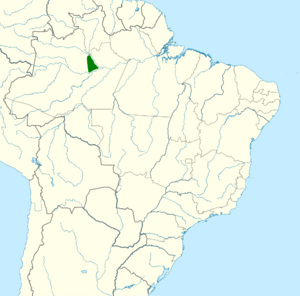Chestnut-headed nunlet facts for kids
Quick facts for kids Chestnut-headed nunlet |
|
|---|---|
| Conservation status | |
| Scientific classification | |
| Genus: |
Nonnula
|
| Species: |
amaurocephala
|
 |
|
The chestnut-headed nunlet (Nonnula amaurocephala) is a small, unique bird found only in Brazil. It belongs to a family of birds called Bucconidae, which includes puffbirds and nunbirds. These birds are known for their quiet nature and often sit still for long periods.
Contents
About the Chestnut-headed Nunlet
The chestnut-headed nunlet is a special bird because it is endemic to Brazil. This means it lives naturally only in that country and nowhere else in the world. It is a type of near-passerine bird, which means it has a different foot structure than perching birds like sparrows.
What Does It Look Like?
The chestnut-headed nunlet is a small bird, about 14 to 15 centimeters (5.5 to 6 inches) long. It weighs around 15 to 16 grams (about half an ounce), which is very light!
Its head, neck, chest, and upper belly are a bright, reddish-brown color, like chestnuts. Its back, wings, and tail are a dull brown. The lower part of its belly is whitish. It has a mostly black beak, red eyes, and gray feet.
Where Does It Live?
This bird lives in a very specific part of Brazil. You can find it in the Amazonas state, which is north of the famous Amazon River and west of the Negro River.
It almost always lives in the lower parts of forests that get flooded during certain seasons. These special forests are called igapó forests. The nunlet usually stays about 3 meters (10 feet) above the ground, but sometimes it might go as high as 8 meters (26 feet).
How Does the Nunlet Behave?
Scientists are still learning a lot about the chestnut-headed nunlet's daily life.
What Does It Eat?
The chestnut-headed nunlet has been seen quickly flying from a perch to catch insects. However, we don't have many details about what exactly it eats or how it hunts for food.
How Does It Raise Its Young?
We don't have much information about how the chestnut-headed nunlet builds its nests or raises its baby birds. This is still a mystery that scientists hope to solve!
What Does It Sound Like?
As of late 2021, there are no recordings or detailed descriptions of the chestnut-headed nunlet's calls or songs. It's known to be a very quiet bird, which makes it harder to study.
Is the Nunlet in Danger?
The IUCN (International Union for Conservation of Nature) keeps track of how many animals are left in the wild. They first thought the chestnut-headed nunlet was "Near Threatened" in 1988. However, since 2004, they have changed its status to "Least Concern". This means it's not currently in immediate danger of disappearing.
Even though its population is believed to be decreasing and it lives in a small area, its igapó forest home is still very common and not under much threat from human activities. Also, because the bird is so quiet and doesn't move around much, it might be harder for scientists to count them all.


